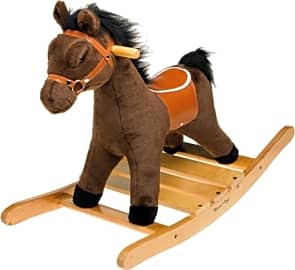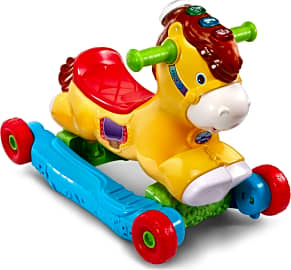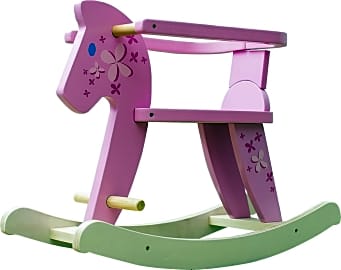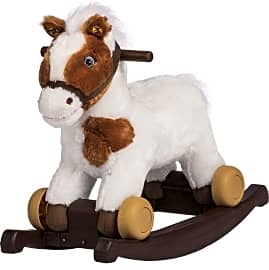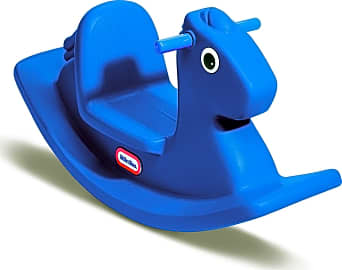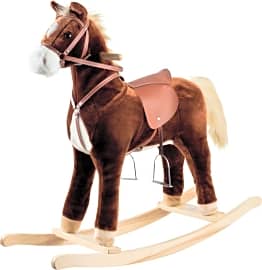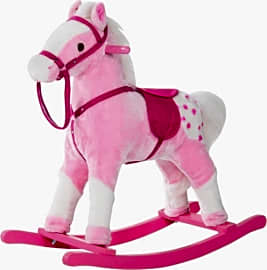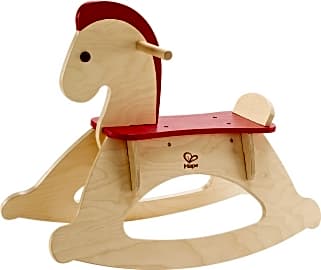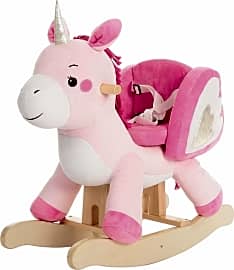The 10 Best Rocking Horses

This wiki has been updated 42 times since it was first published in August of 2015. There's a reason why rocking horses have been a staple in children's nurseries for hundreds of years -- kids absolutely love them. Today's models still retain a sense of timeless charm, but also come with exciting extras, like lights, music and galloping sounds. Many offer safety features that will keep mom and dad happy too, including foot straps and easy-grip handles. When users buy our independently chosen editorial choices, we may earn commissions to help fund the Wiki.
Editor's Notes
January 28, 2020:
Rocking horses are whimsical toys that have been popular among young kids for many generations. In addition to their overall classic design, many now come with fun, interactive bells and whistles. The newly added VTech Gallop and Rock is a colorful model that lights up and plays more than 60 songs, melodies, sounds, and phrases that help teach the colors, animals, and more. A motion sensor detects a child’s movement and encourages them to rock and ride.
Another interactive model is the Melissa & Doug Plush, which makes galloping sounds when its ear is pressed. Its other realistic qualities include ultra-soft fur and a saddle and bridle. It’s easy to mount on the solid wood base and can accommodate up to 150 pounds. The Radio Flyer Blaze can detect how quickly your child is rocking and will emit walking, trotting, and galloping sounds, accordingly. Included accessories are a comb for its mane and a carrot that triggers chewing sounds when it’s placed near the horse’s mouth. This model comes with an on-off switch, which is convenient for when a child (or a parent) prefers quiet play.
For a basic, sturdy model without the sounds and lights, look to the newly added Labebe Ride On, which is made of solid wood and offers wraparound rails to keep little ones safe and sound. The foot pegs can be removed as your little one grows and no longer needs them. It’s offered in an attractive pink with painted-on flowers, or can be purchased in solid white for those who want to decorate it at home to their child’s liking.
Leaving the list today are the KidKraft Derby and the Best Choice Educational, due to issues with availability.
To prevent accidents, always keep a close eye on kids when they are using these toys, to ensure they do not tip over or possibly injure siblings who get too close. At no time should children be permitted to stand on them.
Special Honors
Classic Poplar with Saddle and Bridle Available from Heartwood Rocking Horses, this frolicking horse is made with walnut rockers and a hand-stitched saddle that’s permanently affixed. It features stirrups that are both adjustable and removable, as well as a fully functioning bridle that's also hand stitched, and a mane and tail that are real horse hair. It’s suitable for kids aged four and up and measures 65 inches long, 30 inches tall, and 12 inches wide. heartwoodrockinghorses.com
Amish Wooden Rocking Horse Made in a non-electric Amish shop, this horse is handcrafted with attention to detail and is designed to last for multiple generations. You can choose between oak or cherry construction, as well as one with a padded seat or no padding. It’s suitable for children aged two to five years and has a width of 12 inches, a length of 35 inches, and an overall height of 25 inches. dutchcrafters.com
Plastic Vs. Wood: The Great Debate Wages On
This may not be an issue, however, given a plastic horse will never warp, rot, or splinter apart.
A rocking horse is one of the few classic toys that a child will outgrow before he has learned to differentiate one model from another. As such, it is up to a parent (or a grandparent) to choose a rocking horse for any toddler. By and large, this decision boils down to a simple choice between plastic and wood.
Wooden rocking horses are more traditional than their plastic counterparts, appearing more formal in a living room or an upscale apartment setting. Wooden horses also look more authentic and rustic, and they generally match any type of ranch-style decor.
Plastic horses are more colorful, and they look more appropriate amidst the stimulating palette of a child's nursery or a rec-room area. Plastic horses weigh less (i.e., 8-12 lbs.), and they are more durable and compact. The combination of these benefits makes a plastic horse more appropriate to take along on a vacation, or to drop off at any babysitter's house.
The majority of wooden horses are crafted in such a way that parents can tighten, or reattach, several loosened parts. Plastic horses, on the other hand, are extremely difficult to repair. This may not be an issue, however, given a plastic horse will never warp, rot, or splinter apart.
Wooden horses may periodically need to be sanded down, sharpened, or given a new coat of gloss. Once the paint job on a plastic horse begins to fade or peel, the owner may be out of luck. However, a plastic horse does perform better than a wooden horse on any outdoor surface. Wooden horses are predominately resigned to being ridden indoors, away from nature's elements.
Several Safety Tips For Owning a Rocking Horse
For centuries, small children have gravitated toward rocking horses. A rocking horse spurs the imagination, while also encouraging kids to develop coordination and balance. And yet, a rocking horse could present a minor hazard in the event that a parent doesn't take a few precautions.
This way, if a child gets thrown, or even trips while disembarking, there won't be any broken bones or brush burns.
First and foremost, it helps to place a cushioned mat around the rocking horse. This way, if a child gets thrown, or even trips while disembarking, there won't be any broken bones or brush burns. Make sure that the area surrounding any mat stays clear. Discarded toys can get crushed beneath the weight of a rocking horse, and certain toys can stop a rocking horse abruptly, increasing the chance that your child could get hurt.
Every standard rocking horse comes with a set of handles or reins. Teach your child to keep both hands on these handles at all times, and make it clear to your child never to place a rocking horse's reins around - or behind - his neck.
Children should not be riding on a rocking horse two at a time. More often than not, this leads to either the rear child getting thrown off, or the front child getting knocked forward. It's much safer to train your kids to ride one at a time, and to take turns in the event that they are enjoying the horse along with a sibling or a friend.
When you initially purchase or assemble a rocking horse, be sure to check that all the screws, stirrups, and reins are adjusted tight. It's worth going over the same exercise again in the event that a rocking horse begins to squeak or make any other out-of-the-ordinary noises. If a wooden horse begins to splinter, sand it down, and then add a new layer of gloss. One splinter can - and probably will - lead to more unless the worn wood is provided with a new protective coat.
An Early and Inspirational Account of The Rocking Horse
Charles I, son of King James VI of Scotland, remained unable to walk throughout his early childhood. While the reasons for Charles' immobility have never been uncovered, every historical account agrees that, as a boy, Charles was confined to a wheelchair.
These caregivers implemented a complete regimen of physical therapy, which included - rather curiously - a wooden rocking horse for Charles to ride on.
At the age of five, Charles was named Duke of York by his father. There was increased pressure at this point for Charles to mature, and grow into the demands of that title. The royal family enlisted personal caregivers to help Charles with his education and physical development. These caregivers implemented a complete regimen of physical therapy, which included - rather curiously - a wooden rocking horse for Charles to ride on.
This rocking horse, commissioned while Charles was between the ages of 7 and 10, had been handcrafted by using a single piece of elm. The horse featured a rail-thin saddle and an equally small head (with no apparent handles), and it stood upon a pair of extremely wide, half-crescent blades, both of which ran parallel so that Charles could "rock" back and forth.
Charles spent time on the rocking horse every day. And while it remains unclear how much the exercise directly contributed to alleviating Charles' condition, historical data confirms that Charles was completely mobile, even excelling at equestrian activities, by his early adolescence.
At the age of 25, Charles I became King of Great Britain. The two most famous portraits of Charles feature him as a middle-aged sire on horseback. Charles' original rocking horse has been preserved, and it is on display at the Victoria & Albert Museum in London, where it is a part of the permanent collection.


